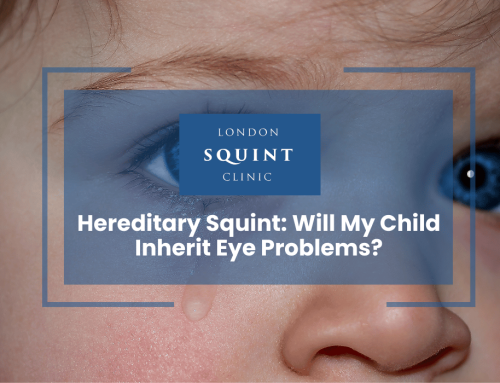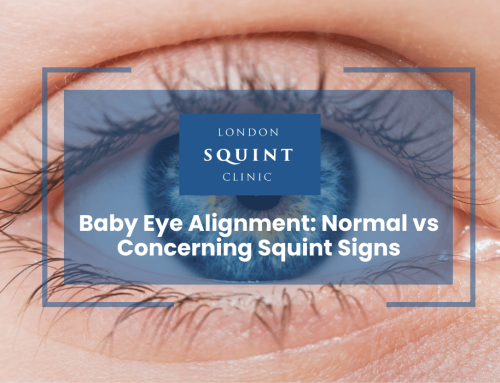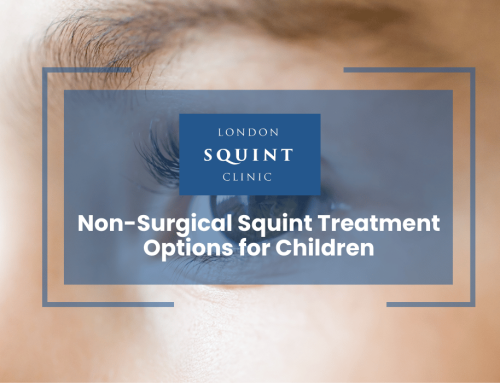Early Warning Signs Your Toddler May Have a Squint
Essential Insights for Parents: Recognizing and Addressing Childhood Squint
Early detection is crucial: While occasional eye misalignment is normal in newborns, persistent turning after 4 months of age requires professional evaluation.
Watch for warning signs: Visible eye misalignment, head tilting, closing one eye in bright light, poor depth perception, and excessive blinking may indicate strabismus.
Untreated squint has consequences: Without intervention, children may develop amblyopia (lazy eye), permanent loss of depth perception, and psychosocial challenges.
Multiple treatment options exist: Depending on the cause and severity, treatments may include corrective eyewear, patching therapy, vision exercises, or surgery.
The window for optimal treatment is limited: The visual system is most adaptable during early childhood, making prompt intervention essential for the best outcomes.
Table of Contents
- Understanding Squint (Strabismus) in Young Children
- Common Signs of Eye Alignment Problems in Toddlers
- When Should Parents Be Concerned About Eye Turning?
- How Age Affects Squint Detection and Development
- Distinguishing Between Normal Vision and Strabismus
- Impact of Untreated Squint on Visual Development
- Seeking Professional Help: What to Expect at Evaluation
- Treatment Options for Toddlers with Strabismus
Understanding Squint (Strabismus) in Young Children
Squint, medically known as strabismus, is a condition where the eyes do not align properly. In toddlers, this misalignment occurs when one eye looks straight ahead while the other turns inward (convergent squint or esotropia), outward (divergent squint or exotropia), upward, or downward. This condition affects approximately 2-4% of children under the age of six years.
The development of normal binocular vision—where both eyes work together to create depth perception—is crucial during the first few years of life. When a child has a squint, the brain receives two different images, which can lead to confusion. To adapt, the brain may begin to ignore the image from the misaligned eye, potentially leading to amblyopia (lazy eye) if left untreated.
Squints in toddlers can be constant (present all the time) or intermittent (occurring occasionally). They may also be accommodative, meaning they appear when the child focuses on near objects or attempts to overcome long-sightedness. Understanding the type and cause of your child’s squint is essential for appropriate treatment and management.
Common Signs of Eye Alignment Problems in Toddlers
Recognising the early warning signs of childhood strabismus symptoms is crucial for timely intervention. Parents should be vigilant for these common indicators of eye alignment problems in their toddlers:
Visible misalignment: The most obvious sign is when one eye appears to turn in a different direction than the other. This may be noticeable all the time or only occasionally, such as when your child is tired or focusing intently.
Head tilting or turning: Toddlers with squint may adopt unusual head positions to help align their eyes or to compensate for double vision. If you notice your child consistently tilting or turning their head when looking at objects, this could indicate an eye alignment issue.
Closing one eye in bright light: Children with intermittent squint in toddlers may squint or close one eye, particularly in bright sunlight or when concentrating on distant objects. This behaviour helps eliminate double vision or visual confusion.
Poor depth perception: Difficulty judging distances, such as trouble catching balls or navigating steps, may suggest binocular vision problems associated with squint.
Excessive blinking or eye rubbing: These behaviours might indicate eye strain or discomfort resulting from the child’s efforts to correct their vision.
Complaints of headaches: Though toddlers may not articulate this clearly, frequent headaches can result from the visual strain of a squint condition.
When Should Parents Be Concerned About Eye Turning?
It’s normal for newborns to have occasional eye misalignment as their visual system develops. However, by 3-4 months of age, a baby’s eyes should maintain proper alignment most of the time. For toddlers, any persistent or recurring eye turning warrants attention.
Parents should be particularly concerned if they notice:
Consistent eye turning after 4 months of age: Any persistent misalignment beyond early infancy requires evaluation. If you’re wondering “when should I worry about my toddler’s eye alignment?”, the answer is that consistent turning at any age beyond 4 months should prompt a consultation.
Sudden onset of squint: If a previously normal-appearing child suddenly develops a squint, this requires urgent assessment as it could indicate a more serious underlying condition.
Squint that appears when your child is unwell: Eye turning that occurs during illness or fever might signal a neurological issue requiring immediate medical attention.
Family history of eye problems: If there’s a family history of strabismus, children should be monitored more closely as they have an increased risk of developing similar conditions.
Remember that early intervention is key. Early detection and treatment of squint significantly improves outcomes and reduces the risk of permanent vision problems. If you’re uncertain whether your toddler’s eye movements are normal, it’s always better to seek professional advice rather than wait and see.
How Age Affects Squint Detection and Development
The relationship between a child’s age and squint development is significant for both detection and treatment outcomes. Understanding these age-related factors can help parents recognise when to seek help for their 2-year-old squinting or other age-specific concerns.
Infancy (0-6 months): Occasional eye misalignment is common in newborns as their visual coordination develops. However, by 3-4 months, eye alignment should become more stable. Persistent misalignment beyond this age requires evaluation.
Toddlerhood (1-3 years): This is a critical period for visual development. Squints that appear during this time may be related to focusing problems (accommodative squint) or muscle imbalances. Detection can be challenging as toddlers cannot reliably report visual symptoms, making parental observation crucial.
Preschool years (3-5 years): By this age, visual pathways are still developing but becoming more established. Squints detected during this period may respond well to treatment, though intervention should begin as soon as possible.
School age (6+ years): While the visual system remains somewhat adaptable, the critical period for development is waning. Squints detected later in childhood may require more intensive treatment and have less optimal outcomes.
The timing of squint development also offers clues about potential causes. Early-onset squints (before age 2) are often related to refractive errors or congenital factors, while later-onset squints might indicate accommodative issues or other developing visual problems. This age-related information helps specialists determine the most appropriate treatment approach.
Distinguishing Between Normal Vision and Strabismus
Parents often wonder whether certain eye behaviours in their toddlers are normal developmental stages or signs of strabismus. This confusion is understandable, as some eye movements can mimic squint without indicating a problem. Here’s how to distinguish between normal vision development and true eye alignment problems:
Pseudostrabismus vs. True Strabismus: Many toddlers appear to have crossed eyes due to a broad nasal bridge and prominent epicanthal folds (skin folds covering the inner corners of the eyes). This condition, called pseudostrabismus, creates an optical illusion of eye misalignment when the eyes are actually straight. A simple test: if the light reflection appears in the same position in both eyes when a torch is shone at them, the alignment is likely normal.
Occasional vs. Persistent Turning: Brief, occasional eye wandering in very young infants (under 3 months) can be normal as they develop eye muscle control. However, any persistent or frequent turning after this age warrants professional assessment.
Focusing Efforts: When toddlers concentrate intensely on near objects, they may occasionally appear slightly cross-eyed due to convergence (the inward turning of eyes to focus on near objects). This is normal if it only occurs during close focus and resolves when looking at distant objects.
Consistent Head Tilting: While all children may occasionally tilt their heads, consistent head tilting to view objects suggests the child is compensating for vision problems and should be evaluated.
If you’re unsure whether your child’s eye alignment is normal, consider that true strabismus typically presents with consistent patterns of misalignment, while normal developmental variations tend to be intermittent and resolve as the child grows.
Impact of Untreated Squint on Visual Development
Untreated squint in toddlers can lead to significant and sometimes permanent visual impairments. Understanding these potential consequences emphasises the importance of early intervention for optimal outcomes.
Amblyopia (Lazy Eye): When a child has a squint, the brain receives two different images—one from each eye. To avoid confusion and double vision, the brain may suppress the image from the misaligned eye. Over time, this suppression can lead to amblyopia, where vision in the affected eye fails to develop properly. Without treatment, this can result in permanent vision loss in that eye.
Loss of Binocular Vision: Normal visual development depends on both eyes working together to create depth perception. Untreated squint disrupts this process, potentially resulting in permanent loss of stereopsis (3D vision). This affects depth perception and spatial awareness, which can impact everyday activities like catching a ball, pouring liquids, or navigating stairs.
Abnormal Head Postures: Children with untreated squint may develop habitual head tilts or turns to compensate for their vision problems. These abnormal postures can eventually lead to musculoskeletal issues affecting the neck and spine.
Psychosocial Impact: Visible eye misalignment can affect a child’s self-esteem and social interactions. Children with noticeable squint may face teasing or bullying, potentially leading to social withdrawal or behavioural problems.
Academic Challenges: Visual difficulties associated with untreated squint can interfere with learning activities such as reading, writing, and sports, potentially affecting academic performance and development.
The good news is that with early detection and appropriate treatment, many of these consequences can be minimised or avoided entirely. The visual system remains relatively plastic during early childhood, making this the optimal window for intervention.
Seeking Professional Help: What to Expect at Evaluation
When you decide to seek professional help for your toddler’s potential squint, understanding the pediatric ophthalmology assessment process can help ease anxieties for both you and your child. Here’s what typically happens during an evaluation:
Initial History Taking: The appointment usually begins with questions about your child’s visual behaviours, developmental milestones, and family history. Be prepared to discuss when you first noticed the eye turning, whether it’s constant or intermittent, and any family history of strabismus or other eye conditions.
Visual Acuity Testing: For toddlers, age-appropriate methods are used to assess vision. Rather than reading letters, young children might be asked to identify pictures or match shapes. For very young children, preferential looking tests (where the child’s attention to specific patterns is observed) may be used.
Alignment Assessment: Several tests evaluate eye alignment. The Hirschberg test involves shining a light into the eyes and observing where the reflection appears on each cornea. The cover test, where one eye is covered and then uncovered while the child focuses on an object, helps detect even subtle misalignments.
Refraction Assessment: Eye drops may be administered to temporarily paralyse the focusing muscles (cycloplegia), allowing accurate measurement of any refractive errors like long-sightedness, short-sightedness, or astigmatism. This is important as uncorrected refractive errors can cause certain types of squint.
Eye Health Examination: The specialist will examine the structures of the eye to rule out any underlying conditions that might cause squint.
Additional Tests: Depending on the findings, additional assessments of depth perception, eye movements, and focusing ability may be conducted.
The entire evaluation is conducted in a child-friendly manner, often incorporating play elements to keep toddlers engaged. Following the assessment, the specialist will discuss their findings and recommend an appropriate treatment plan if necessary.
Treatment Options for Toddlers with Strabismus
Treatment for toddlers with strabismus varies depending on the type, cause, and severity of the squint. Early intervention typically yields the best results, with several approaches available:
Corrective Eyewear: For accommodative squint (caused by uncorrected long-sightedness), prescription glasses can help the eyes focus properly without overexertion, often resolving the misalignment. These specially designed children’s glasses are made to be durable and comfortable for active toddlers.
Patching Therapy: If amblyopia (lazy eye) has developed, patching the stronger eye forces the weaker eye to work harder, strengthening its vision. The patching schedule depends on the severity of the amblyopia and the child’s age, typically ranging from a few hours daily to most waking hours.
Atropine Eye Drops: As an alternative to patching, these drops temporarily blur vision in the stronger eye, encouraging use of the weaker eye. This method is sometimes preferred for toddlers who resist wearing patches.
Vision Therapy: Specific eye exercises may be prescribed to improve eye coordination and strengthen the eye muscles. These exercises are tailored to the child’s age and ability to follow instructions.
Prism Lenses: Special lenses that bend light can help align images for both eyes, reducing double vision and improving binocular function in some cases.
Surgical Correction: When non-surgical approaches are insufficient, surgery may be recommended to realign the eyes by adjusting the eye muscles. Surgery is typically considered when:
– The squint is large or constant
– Non-surgical methods haven’t been effective
– The squint is causing significant functional or cosmetic concerns
Combined Approaches: Often, the most effective treatment involves a combination of these methods. For example, glasses might be prescribed first, followed by patching therapy and possibly surgery.
Regular follow-up appointments are essential to monitor progress and adjust treatment as needed. With appropriate intervention, many toddlers with strabismus can achieve good eye alignment and visual development, particularly when treatment begins early.
Frequently Asked Questions
At what age should a child’s eye turning be considered abnormal?
Occasional eye misalignment is normal in newborns up to 3-4 months as their visual system develops. However, any persistent or consistent eye turning after 4 months of age should be evaluated by a healthcare professional. By 6 months, a baby’s eyes should maintain proper alignment most of the time. Early detection is crucial, as treatment outcomes are generally better when intervention begins before age 2.
Can a toddler’s squint correct itself without treatment?
While some minor, intermittent squints in very young infants may resolve as visual development progresses, most true squints (strabismus) in toddlers will not correct themselves without intervention. Accommodative squints related to uncorrected long-sightedness typically require glasses, and constant squints usually need medical treatment. Waiting to see if a squint will self-correct risks developing amblyopia (lazy eye) and permanent vision problems.
How can I tell if my child has pseudostrabismus or true strabismus?
Pseudostrabismus is an illusion of eye misalignment caused by facial features like a broad nasal bridge or prominent epicanthal folds, while true strabismus involves actual eye misalignment. A simple way to differentiate: shine a penlight at your child’s eyes and observe the reflection. In pseudostrabismus, the light reflection appears in the same position in both eyes; in true strabismus, the reflections appear in different positions. Only a professional examination can definitively distinguish between the two conditions.
Will my child need to wear glasses forever if diagnosed with squint?
Not necessarily. The need for long-term glasses depends on the type of squint and its underlying cause. For accommodative squints caused by long-sightedness, some children may outgrow the need for glasses as their eyes develop. However, others may require glasses long-term. Regular eye examinations throughout childhood will determine if and when prescription changes or discontinuation of glasses is appropriate.
How successful is squint surgery for toddlers?
Squint surgery in toddlers has a success rate of approximately 60-80% for achieving satisfactory alignment with a single procedure. Some children (20-40%) may require additional surgeries to achieve optimal results. Success rates are generally higher when surgery is combined with appropriate non-surgical treatments like glasses and patching. Early intervention typically yields better outcomes, as the visual system remains more adaptable during the first few years of life.
Can squint affect my child’s learning and development?
Yes, untreated squint can impact a child’s learning and development in several ways. It may lead to amblyopia (reduced vision), poor depth perception, and visual processing difficulties that affect reading, writing, and spatial awareness. Children with squint may struggle with activities requiring hand-eye coordination and experience headaches or eye strain. Additionally, visible eye misalignment can affect self-esteem and social interactions. Early treatment significantly reduces these risks and supports normal visual development.
How often will my child need follow-up appointments after squint diagnosis?
Follow-up frequency depends on the type of squint, treatment plan, and your child’s age. Initially, appointments may be scheduled every 1-3 months to monitor treatment effectiveness and adjust as needed. Children undergoing patching therapy or wearing new glasses typically require more frequent monitoring. After stabilization, visits may be reduced to every 4-6 months. Post-surgical patients need close follow-up initially, then transition to regular monitoring. Consistent attendance at recommended appointments is essential for optimal outcomes.
Find out if you are suitable for Double Vision Treatment
Not everyone is eligible for double vision surgery.
Find out if you could benefit from this life-changing surgery by taking the quick self-suitability quiz below:
Our most popular procedures

Hello, I’m Nadeem Ali
I’m one of the few eye surgeons in the world with 100% focus on Squint and Double Vision Surgery.
I have 24 years of eye surgery experience, and worked for 13 years as a Consultant at London’s renowned Moorfields Eye Hospital.
In 2023, I left the NHS to focus fully on treating patients from across the world at the London Squint Clinic. You can read more about me here.
There’s lots of information on the website about: squint surgery, double vision surgery and our pricing.
The most rewarding part of my job is hearing patients tell me how squint or double vision surgery has changed their lives. You can hear these stories here.
Mr Nadeem Ali
MA MB BChir MRCOphth FRCSEd(Ophth)





